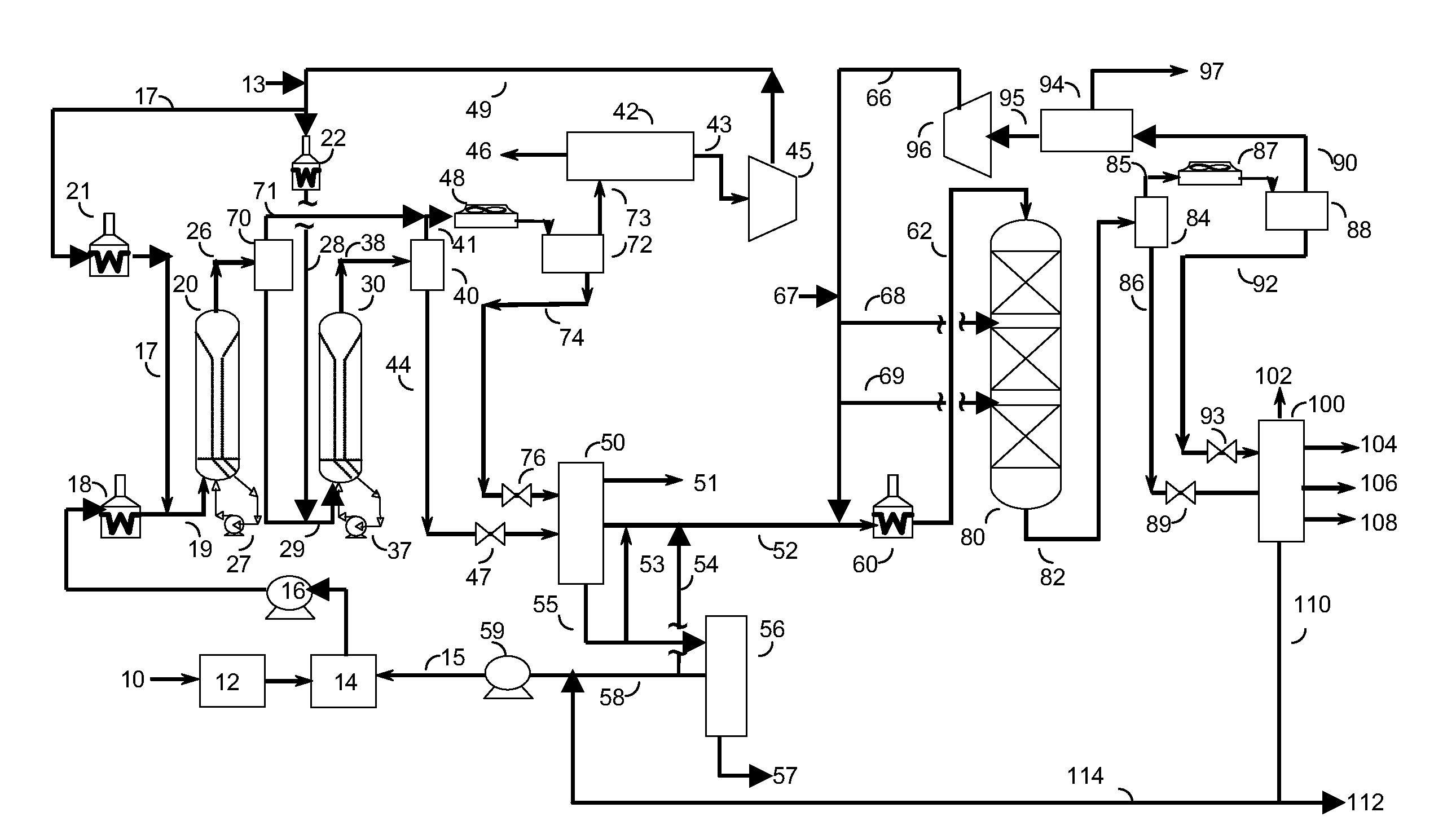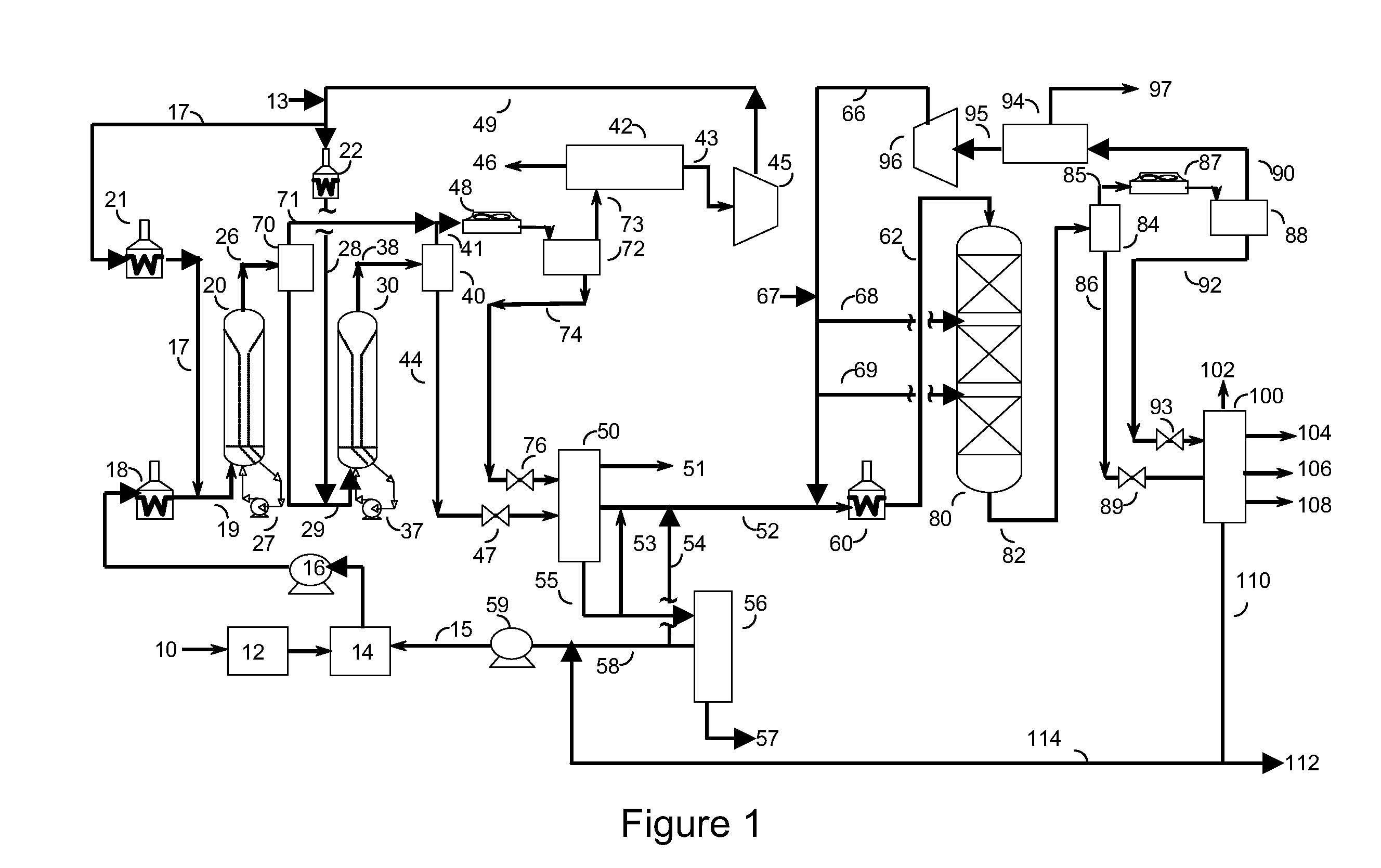Coal conversion process and products, comprising two direct ebullated bed liquefaction stages and a fixed bed hydrocracking stage
a technology of hydrocracking and coal conversion process, which is applied in the direction of hydrocarbon oil treatment products, waste based fuels, fuels, etc., can solve the problems of poor quality and more astonishing, and achieve the effect of high yield
- Summary
- Abstract
- Description
- Claims
- Application Information
AI Technical Summary
Benefits of technology
Problems solved by technology
Method used
Image
Examples
example 1
Liquefaction Stages
[0186]The two liquefaction stages in ebullated bed reactors were carried out with bituminous type coal which had been ground and dried. The operating conditions for the liquefaction are shown in Table 1; the liquefaction yields are shown in Table 2.
TABLE 1operating conditions for two-stage liquefactionCatalystNiMo / aluminaTemperature, reactor R1 (° C.)410Temperature, reactor R2 (° C.)440Pressure, MPa17HSV R1 (kg / h dry coal / kg catalyst)1.2HSV R2 (kg / h dry coal / kg catalyst)1.2H2 inlet (Nm3 / kg dry coal)2.8Recycle, liquid / coal1.1
TABLE 2yields for two-stage liquefaction (wt % / dry coal)C1-C4 (gas)13.53C5-199° C.14.00199-260° C.9.79260-343° C.21.52343-388° C.13.54388-454° C.4.04454-523° C.1.20523° C.+2.41Unconverted coal + ash13.23H2O / CO / CO2 / NH3 / H2S13.80
example 2
Hydrocracking Stage
[0187]The C5-199° C., 199-260° C., 260-343° C. and 343-388° C. cuts obtained in the separation stage at the liquefaction outlet were sent to the hydrocracking stage. The portion of the heavy fraction which was not recycled, the unconverted coal and the ash were sent to the gasification stage in order to produce H2. The operating conditions for hydrocracking are shown in Table 3; the hydrocracking yields are shown in Table 4.
TABLE 3operating conditions for hydrocrackingCatalystNiW / silica-aluminaPressure, MPa16Temperature (° C.)390HSV (Nm3 / h C5-388° C. / m3 of catalyst)0.5H2 / HC, reactor inlet (Nm3 / h H2 / Nm3 C5-388° C.)1500
TABLE 4yields for hydrocracking (wt % / dry coal)H2S / NH3 / H2O1.0C1-C40.81C5-200° C.19.16200-250° C.11.83250° C.+27.73200° C.+39.56343° C.+4.02
[0188]Table 5 shows the physico-chemical properties of the 200° C.+ cut of the hydrocracked coal from liquefaction as well as the properties of the kerosene cut and the gas oil cut obtained by distillation of this ...
example 3
Hydrotreatment Stage (Not in Accordance With the Invention)
[0191]In order to explain the hydrotreatment effect on the liquefaction effluent, a complementary test was carried out by hydrotreating the C5-199° C., 199-260° C., 260-343° C. and 343-388° C. cuts obtained in the separation stage at the liquefaction outlet of Example 1. The operating conditions for the fixed bed hydrotreatment are shown in Table 7.
TABLE 7operating conditions for hydrotreatmentCatalystNiMo / aluminaPressure, MPa13Temperature (° C.)375HSV (Nm3 / h C5-388° C. / m3 of catalyst)0.75H2 / HC (Nm3 / h H2 / Nm3 C5-388° C.)300
[0192]The ASTM D 3238 analyses were carried out on the 200-350° C. (kerosene+diesel) cuts obtained using the H-Coal TS process under the conditions of Example 1, obtained after hydrocracking (HCK) under the conditions of Example 2 and after hydrotreatment (HDT) under the conditions of Example 3. These analyses as shown in Table 8.
TABLE 8change in structure of 200-350° C. cut as function of treatmentUsing H-...
PUM
| Property | Measurement | Unit |
|---|---|---|
| temperature | aaaaa | aaaaa |
| total pressure | aaaaa | aaaaa |
| total pressure | aaaaa | aaaaa |
Abstract
Description
Claims
Application Information
 Login to View More
Login to View More - R&D
- Intellectual Property
- Life Sciences
- Materials
- Tech Scout
- Unparalleled Data Quality
- Higher Quality Content
- 60% Fewer Hallucinations
Browse by: Latest US Patents, China's latest patents, Technical Efficacy Thesaurus, Application Domain, Technology Topic, Popular Technical Reports.
© 2025 PatSnap. All rights reserved.Legal|Privacy policy|Modern Slavery Act Transparency Statement|Sitemap|About US| Contact US: help@patsnap.com



